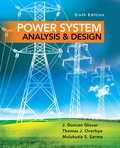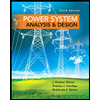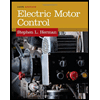
EBK POWER SYSTEM ANALYSIS AND DESIGN
6th Edition
ISBN: 9781305886957
Author: Glover
Publisher: CENGAGE LEARNING - CONSIGNMENT
expand_more
expand_more
format_list_bulleted
Concept explainers
Question
error_outline
This textbook solution is under construction.
Students have asked these similar questions
The following circuit is at steady state for t<0. At t=0 sec, the switch is open. Let R₁ =14 ohms, R₂=14
ohms, R3-4 ohms, C₁-1 F, Vx-16 V and Ix-7 A. Find Vc1 (0.8 sec) and voltage across resistor R3 = v(1.4 sec),
as follows:
Vc1(0) in volts=
Vc1(00) in volts=
Rth in ohms=
Vc1(t-0.8 sec) in volts=
v(t-1.4 sec) in volts=
Vx
w
t=0
The relative tolerance for this problem is 10 %.
+
www
R₂
Vit
R3
+
Vc1(t)
C₁
For the circuit shown, the switch opens at t=0 sec. Find i(t=1.5) value as follows.
Let R1-12 ohm, R₂-8 ohm, L=0.6 H, V≤1-10 V and V2-8 V, and determine:
i(0) =
A
A
i(∞0) =
Rth
=
i(1.5 sec)
Ω
A
R₁
L
i(t)
VS2
R2
w
The relative tolerance for this problem is 9 %.
+
V S1
You must have noticed that, when a major appliance is turned on (such as an AC unit, garbage disposal,
etc.), your house lights dim momentarily. This is the effect of the RL circuit formed by the inductance and
resistance of the transmission line and the loads (light bulbs, appliance, etc.) In fact, even a single straight
wire has inductance. The inductance (and the resistance) of a long transmission line can be problematic if
the system is not properly designed.
The voltage on a power transmission line is alternating current but the effect of transmission line can be
simulated by a DC circuit as shown below, where R=0.005 2 /km and L=0.04 H/km representing the
resistance and inductance of the transmission line per km relationship that is with the ration: L-8 R.
In the circuit, Right =160 represents light bulb resistances, R₁ = 7
represents the resistance of a
'major appliance', and the switch indicates when the appliance is turn on.
Alice, a newly hired engineer, needs to determine…
Knowledge Booster
Learn more about
Need a deep-dive on the concept behind this application? Look no further. Learn more about this topic, electrical-engineering and related others by exploring similar questions and additional content below.Similar questions
- For the circuit shown, let Let R₁-3 ohms, R2-7 ohms, C₁-2 F, VX-20 V and Ix-1 A. Calculate the capacitor voltages, as shows, at time t= (-1.3) sec and at t=1.9 sec. In particular find: V(0) = V(∞) = Rth V(t=-1.3 sec) in volts- V(t-1.9 sec) in volts- C1 HH +V(t) = - (V) (V) (S2) (V) 3 (V) Vx +1 R1 t=0 The relative tolerance for this problem is 9 %. R₂arrow_forwardIn the circuit below, the switch moves from position 1 to position 2 at t=0. Select the closest waveform which represents the inductor current: 2 R 2R V₁ t=0 0 t=0 (a) (d) t=0 (b) (e) 0 0 t=0 (c) t=0 요 (f) Note: choices are listed randomly; may not alphabetically ordered. (given during job interview question, with permission) waveform c waveform a O waveform d waveform e waveform b ○ waveform f t=0 Rarrow_forwardLet R1-8 ohms, R₂-5 ohms, L₁-2 H, Vx=10 V, in the circuit shown, to calculate the inductor current at time t= (0.6 sec) and at t= 2 sec, as follows: i(0) = 1(00) - Rth= = i(0.6 sec) = i(2 sec) = R₁ (A) (A) (N) Vx 1=0 The relative tolerance for this problem is 9 %. (A) (A) R2 ell 4₁arrow_forward
- The following circuit is at steady state for t<0. At t=0 sec, the switch opens. Let R₁=102, R₂-12 2, R3=6 2, R4-6, C=0.9 F and V₂-14 V, and find V(t) at t =2.206 sec, as follows: V(0) = (V) V(∞0) = RTh = V(2.206) = (V) (Ω) (V) {To avoid errors, and meet allowed tolerance, carry-out your intermediate numerical values as much as possible than round only the entered values to 3 significant digits} R₁ w V (+ R₂ ww + C EV(t) R3 The relative tolerance for this problem is 10 %. Question Help: Written Example I R4 www 2=0arrow_forwardPM Mon Apr 14 la800803.us.archive.org Chapter 5 Problems 199 5-8 5-9 carry generator of Fig. 5-5. Derive the two-level Boolean expression for the output carry Cs shown in the look-ahead How many unused input combinations are there in a BCD adder? 5-10 Design a combinational circuit that generated the 9's complement of a BCD digit. 5-11 Construct a 4-digit BCD adder-subtractor using four BCD adders, as shown in Fig. 5-6, and four 9's complement circuits from Problem 5-10. Use block diagrams for each compo- nent, showing only inputs and outputs. 5-12 It is necessary to design a decimal adder for two digits represented in the excess-3 code. Show that the correction after adding the two digits with a 4-bit binary adder is as fol- lows: (a) The output carry is equal to the carry from the binary adder. = (b) If the output carry 1, then add 0011. (c) If the output carry = 0, then add 1101. Construct the decimal adder with two 4-bit adders and an inverter. 5-13 Design a combinational circuit…arrow_forwardFor the circuit shown, assume the initial capacitor voltage is V(0-) = -8 V. Then at t=0, the switch closes. Find the time at which Vc(t)-8 V. Let R₁-12 S2, C1-8 F and V₂-16 V The voltage Vc(∞ )= Time-constant T= The time at which Vc(t)-8 V ist = (V) (sec) (sec) + R1 C₁ + Vct) The relative tolerance for this problem is 10 %.arrow_forward
- 13. Find i(t) for t > 0 in the following circuitarrow_forwardCalculate the Capacitor Voltage for t > 0 assuming the switch has been open for long time.arrow_forward14. Find i(t) for t > 0 in the following circuit Note: the current source is only ON for t > 0. So, it would be an open circuit for t < 0arrow_forward
- 10. Find v(t) for t > 0 in the following circuit. Note: the current source is only ON for t > 0. So, it would be an open circuit for t < 0arrow_forward3. Calculate the Capacitor Voltage for the t 0 for the following circuit. 302 292 12 V 4 V 3 F 2arrow_forward12. Find v(t) and i(t) for t > 0 in the following circuit • Note: the current source is only ON for t > 0. So, it would be an open circuit for t < 0 • Note: assume v(0) = 0V and i(0) = 0A.arrow_forward
arrow_back_ios
SEE MORE QUESTIONS
arrow_forward_ios
Recommended textbooks for you
 Power System Analysis and Design (MindTap Course ...Electrical EngineeringISBN:9781305632134Author:J. Duncan Glover, Thomas Overbye, Mulukutla S. SarmaPublisher:Cengage Learning
Power System Analysis and Design (MindTap Course ...Electrical EngineeringISBN:9781305632134Author:J. Duncan Glover, Thomas Overbye, Mulukutla S. SarmaPublisher:Cengage Learning

Power System Analysis and Design (MindTap Course ...
Electrical Engineering
ISBN:9781305632134
Author:J. Duncan Glover, Thomas Overbye, Mulukutla S. Sarma
Publisher:Cengage Learning

How does an Alternator Work ?; Author: Lesics;https://www.youtube.com/watch?v=tiKH48EMgKE;License: Standard Youtube License